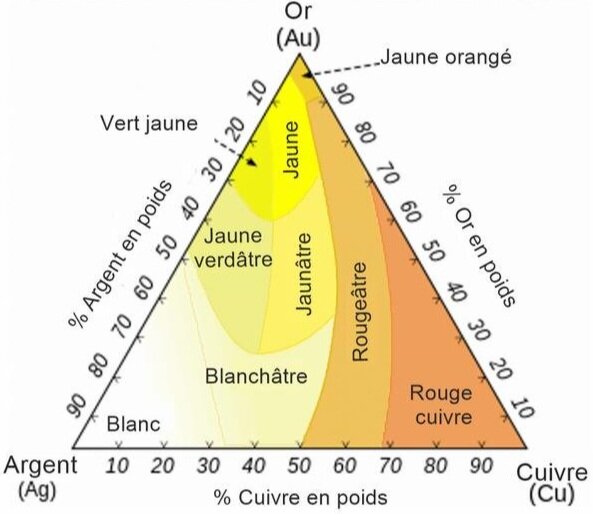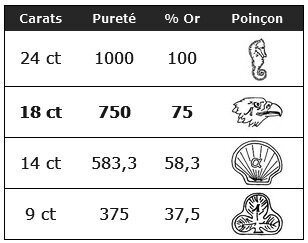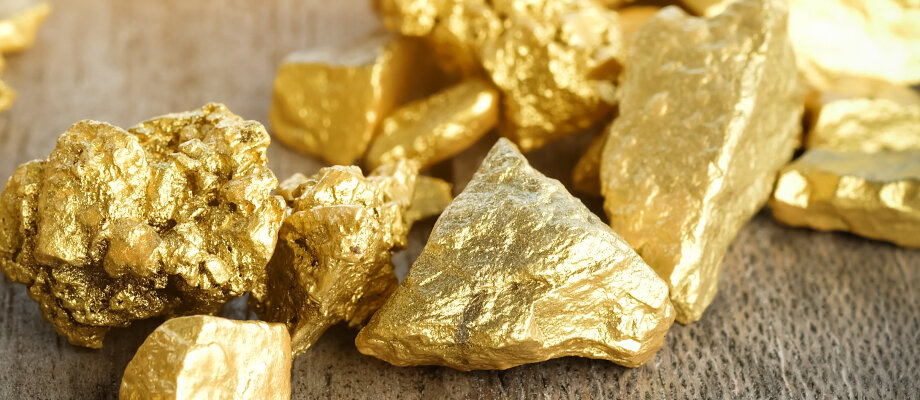Do you know the different caratages of gold?
When buying gold jewelry, it's important to be aware of the subtleties of the different types of gold on the market. On the surface, they may appear similar, but in reality, the opposite is true. Between 9-carat gold, 14-carat gold,18K gold and 24-carat gold, the specifics are of paramount importance. This article aims to shed some light on gold caratage and why Poinçon 22 only uses18K gold and platinum.
A FEW BASICS
If you're thinking of buying gold jewelry, the first thing you need to do is understand the concept of carat to appreciate the quality of the gold you'll be wearing.
The unit of measurement for the purity of precious metals is the carat, designated by the letter "k", which indicates the percentage of pure or fine gold present in your jewelry. The higher the caratage, the purer the gold.
Be careful not to confuse this with "carat", the unit of weight used to weigh diamonds and precious stones. Although they sound exactly the same, the two words are very different.
Solid gold cannot be pure. 24-carat gold is considered 99.9% pure gold and represents the highest purity you can buy. However, it is too soft to be transformed into jewelry.
In order to overcome this problem of rigidity, craftsmen add an "alloy" which is composed of other metals such as zinc, copper or silver for example, to make the gold harder. By varying the metals that make up the alloy, we can create different colors such as yellow gold, rose gold, white gold, red gold, black gold or even green gold!
It is from this alloy content that the caratage of the gold is derived. The composition of gold with other metals is called gold titration. In France, the gold grades most commonly used in jewelry and fine jewelry are18K gold, 14-carat gold and 9-carat gold. 24-carat gold is often purchased as an investment in the form of ingots.
Why 18, 14 or 9 carats? These numbers represent 1/24th of the total mass of an alloy. We take a base of 24 in reference to 24-carat gold, which is the purest. For example,18K gold means 75% pure gold (18/24 x 100 = 75%).
To certify the value and karatage of a piece of gold jewelry, it's essential to have a gold hallmark. Most often, we find the gold hallmark stamped on the inside or outside of the ring. On a gold necklace, chain or bracelet, whatever the color of the gold, it's found at one end, near or on the clasp. On watches, the engraving is found on the case, either inside or outside.
Look out for the square hallmarks. They indicate that the jewelry is gold- or silver-plated.
DIFFERENT GOLD TITRATIONS
24-carat gold
As previously mentioned, this grade of gold is used more as an investment than for jewelry. Although it's the purest, it tends to damage easily because it's softer. So, with 24K gold, you'll have rings that deform every time you wear them.
18K Gold or 750/1000 gold
18K gold is 75% pure gold, which is why we also call it 750/1000 gold. You'll notice here that the alloy is far less important than the gold. This is the traditional alloy of the great French jewelry houses, the noblest and most precious after 24-carat gold. Imposed as a standard of use, it represents, in their view, the best balance between gold "caratage" and alloyed metals. 18K gold is highly appreciated for jewelry that you want to pass on. You can wear it every day, confident that it will last for generations, like a wedding or engagement ring. In fact, it's the kind of titling that provides the solidity needed to hold the stones in place and see them through the generations. It's an undeniable guarantee of gold quality.
Poinçon 22 uses this alloy for all its creations.
14-carat or 583/1000 gold
14K gold, also known as 583/1000 gold, contains 58.3% pure gold. Because it is composed of more alloy, 14K gold jewelry is more affordable than 18K gold. However, it is more fragile and less durable than 18K gold.
9-carat or 350/1000 gold
9K gold, or 375/1000 gold, is made from an alloy containing only 37.5% pure gold. It is therefore composed of more alloy than gold. This type of titling is often used for costume jewelry, as it is more economical. Despite its good durability, it tends to oxidize and tarnish over time due to its low gold content. Purchasing 375/1000 gold jewelry therefore does not seem to be the best grade for wedding rings, engagement rings or any high-quality gold jewelry intended to be handed down through the generations. It's important not to confuse this with18K gold , which contains more than twice as much pure gold as 9-carat gold.
THE DIFFERENT PRICES
The difference in purity of gold grades leads to a difference in price, brilliance and quality. Thus, 375/1000 gold will be less expensive than 583/1000 gold, itself less expensive than 750/1000 gold, whatever the color of the gold. The purest, and therefore most expensive, is 24K gold.
The choice between different gold grades will depend on your priorities, your use, the jewel and your budget.
Poinçon 22 has decided to use only18K gold and platinum for its creations. This is the best balance between luxury, the brilliance of gold and durability. 18-carat jewelry does not change over time. They do not tarnish, fade or flake. Frequently used in jewelry and haute joaillerie, 750/1000 gold enables the manufacture of jewelry set with diamonds and precious stones of the highest quality.
From now on, when you buy a piece of jewelry, you'll be able to ask yourself the right questions to choose the gold carat that suits you best. Is it a piece of costume jewelry that you'll wear for a season, a piece that's hard-wearing but not too precious, or a piece that you'll be able to wear indefinitely?








